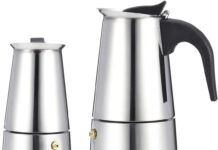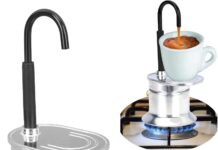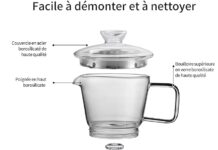In this article, we will share some tips and tricks on how to effectively clean your Bialetti cookware. Whether you are a seasoned chef or just starting to explore the joys of cooking, maintaining the cleanliness of your cookware is essential for both hygiene and longevity. We understand that cleaning cookware can be a daunting task, especially when it comes to removing stubborn stains and grease. But fear not! With our helpful advice, you’ll be able to restore your Bialetti cookware to its sparkling clean state in no time. So, let’s get started and uncover the secrets to keeping your favorite cookware spotless and ready for your next culinary adventure.
1. Cleaning Bialetti Cookware
1.1. Importance of Cleaning Bialetti Cookware
Cleaning Bialetti cookware is essential for maintaining its durability and ensuring the longevity of your investment. Regular cleaning not only keeps your cookware looking shiny and new but also removes any built-up residues and prevents the transfer of flavors and odors between different dishes. By following a proper cleaning routine, you can ensure that your Bialetti cookware stays in top condition, allowing you to enjoy delicious meals for years to come.
1.2. Materials Needed for Cleaning
To effectively clean your Bialetti cookware, you will need a few basic materials. These include a mild dishwashing detergent, a non-abrasive sponge or cloth, a soft-bristle brush, baking soda, white vinegar, and warm water. While these are the general materials needed for cleaning Bialetti cookware, specific types of cookware may require additional cleaning agents or tools, which we will discuss further in the corresponding sections.
1.3. Regular Cleaning Routine
Maintaining a regular cleaning routine for your Bialetti cookware is key to keeping it in pristine condition. After each use, make it a habit to wash your cookware promptly. Start by rinsing off any food particles or residue with warm water. Next, apply a small amount of mild dishwashing detergent to a non-abrasive sponge or cloth and gently scrub the interior and exterior surfaces of the cookware. Rinse thoroughly with warm water, ensuring that no soap residue remains.
1.4. Cleaning Specific Bialetti Cookware Types
Different types of Bialetti cookware require specific cleaning methods. Here, we will discuss the proper cleaning techniques for some popular Bialetti cookware types:
2. Cleaning Bialetti Moka Pot
2.1. Disassembling the Moka Pot
Before cleaning your Bialetti Moka Pot, it is essential to disassemble its various components. Gently unscrew the top part of the pot from the bottom chamber. Separate the funnel and the rubber gasket from the top part of the pot.
2.2. Handwashing the Moka Pot Parts
To clean the Moka Pot parts, it is best to wash them by hand. Use warm water and mild dishwashing detergent to clean the various components. You can use a soft-bristle brush or sponge to clean the inside of the funnel and the rubber gasket thoroughly. Rinse each part with warm water to remove any soap residue.
2.3. Deep Cleaning the Moka Pot
Over time, your Moka Pot may develop a layer of coffee residue or stains. To deep clean the pot, fill the bottom chamber with water and add two tablespoons of baking soda or white vinegar. Place the funnel in its position and screw the top part of the pot onto the bottom chamber. Heat the Moka Pot on a low flame for approximately ten minutes. Allow the mixture to cool, then empty and rinse the pot thoroughly with warm water.
2.4. Removing Coffee Stains from Moka Pot
If your Moka Pot has stubborn coffee stains, you can use a mixture of baking soda and water to remove them. Make a paste by combining baking soda and water, then apply it to the stained areas of the Moka Pot. Let the paste sit for a few minutes, then scrub the stains with a soft-bristle brush or sponge. Rinse the pot thoroughly with warm water to remove any remaining residue.
3. Cleaning Bialetti Ceramic Cookware
3.1. Preparing the Ceramic Cookware
Before cleaning your Bialetti ceramic cookware, it is essential to remove any excess food particles using a soft cloth or sponge. Rinse the cookware with warm water to ensure that no residual food remains.
3.2. Cleaning the Interior Surface
To clean the interior surface of your Bialetti ceramic cookware, prepare a solution of warm water and mild dishwashing detergent. Use a non-abrasive sponge or cloth to gently scrub the interior surface, removing any food residues or stains. Rinse the cookware thoroughly with warm water to remove any soap residue.
3.3. Removing Stubborn Stains
If your Bialetti ceramic cookware has stubborn stains, you can create a paste using baking soda and water. Apply the paste to the stained areas and let it sit for a few minutes. Use a soft-bristle brush or sponge to scrub the stains gently. Rinse the cookware thoroughly to remove any residue.
3.4. Maintaining the Ceramic Cookware
To maintain the shine and longevity of your Bialetti ceramic cookware, avoid using abrasive cleaning agents or metal scrubbers that can scratch the surface. Instead, opt for non-abrasive cleaning tools and mild detergents. Additionally, avoid exposing your ceramic cookware to sudden temperature changes as it may cause thermal shock and damage the cookware.
4. Cleaning Bialetti Non-Stick Cookware
4.1. Handwashing Non-Stick Cookware
Cleaning Bialetti non-stick cookware requires gentle care to preserve the integrity of the non-stick coating. Always wash non-stick cookware by hand using warm water and mild dishwashing detergent. Use a soft sponge or cloth to clean the interior and exterior surfaces, ensuring that you don’t use any abrasive materials that can scratch or damage the non-stick coating.
4.2. Removing Stuck-on Food
For stubborn, stuck-on food, soak the non-stick cookware in warm water with a few drops of mild dishwashing detergent. Allow it to sit for a few minutes to loosen the residue, then gently scrub with a non-abrasive sponge or cloth. Rinse thoroughly with warm water after cleaning to remove any soap residue.
4.3. Cleaning the Exterior Surface
To clean the exterior surface of your Bialetti non-stick cookware, wipe it down with a damp cloth or sponge. If there are any stubborn stains, create a paste using baking soda and water, then gently scrub the stains with a soft-bristle brush. Rinse the cookware with warm water and dry it thoroughly.
4.4. Seasoning Non-Stick Cookware
Periodically seasoning your Bialetti non-stick cookware helps maintain its non-stick properties. To season, rub a small amount of cooking oil onto the interior surface using a soft cloth or paper towel. Heat the cookware on low heat for a few minutes. Allow it to cool, then wipe off any excess oil with a clean cloth.
5. Cleaning Bialetti Aluminum Cookware
5.1. Proper Care for Aluminum Cookware
Bialetti aluminum cookware is known for its excellent heat conduction and durability. To keep it in pristine condition, avoid using abrasive cleaning agents or metal utensils that can scratch the surface. Additionally, ensure that you use gentle cleaning techniques to prevent damage to the aluminum material.
5.2. Handwashing Aluminum Cookware
To clean your Bialetti aluminum cookware, always wash it by hand with warm water and mild dishwashing detergent. Use a non-abrasive sponge or cloth to gently scrub the interior and exterior surfaces, removing any food residues or stains. Rinse thoroughly with warm water to remove any soap residue.
5.3. Removing Burnt Food
If your Bialetti aluminum cookware has burnt-on food, fill the pot or pan with warm water and add a few drops of mild dishwashing detergent. Bring the mixture to a gentle boil and let it simmer for a few minutes. Use a soft-bristle brush or sponge to scrub away the burnt food, then rinse the cookware thoroughly with warm water.
5.4. Dealing with Stubborn Stains
For stubborn stains on your Bialetti aluminum cookware, create a paste using baking soda and water. Apply the paste to the stained areas and let it sit for a few minutes. Gently scrub the stains using a soft-bristle brush or sponge. Rinse the cookware thoroughly to remove any residue.
6. Cleaning Bialetti Stainless Steel Cookware
6.1. Handwashing Stainless Steel Cookware
Cleaning Bialetti stainless steel cookware is relatively straightforward. Begin by handwashing the cookware with warm water and mild dishwashing detergent. Use a non-abrasive sponge or cloth to scrub the interior and exterior surfaces, ensuring that you remove any food residue or stains. Rinse thoroughly with warm water to eliminate any soap residue.
6.2. Cleaning Burnt Stainless Steel
If your Bialetti stainless steel cookware has burnt food, fill the pot or pan with warm water and add a few drops of mild dishwashing detergent. Bring the mixture to a gentle boil and let it simmer for a few minutes. Use a soft-bristle brush or sponge to scrub away the burnt food, then rinse the cookware thoroughly with warm water.
6.3. Removing Discoloration
Over time, stainless steel cookware may develop discoloration or watermarks. To remove these, create a paste using baking soda and water. Apply the paste to the discolored areas and gently scrub with a soft-bristle brush or sponge. Rinse the cookware thoroughly to remove any residue and restore its shine.
6.4. Polishing Stainless Steel Cookware
To maintain the luster of your Bialetti stainless steel cookware, you can use a stainless steel polish. Apply a small amount of polish to a soft cloth and buff the cookware in circular motions. This will help remove any fingerprints, water spots, or minor scratches, leaving your cookware looking shiny and clean.
7. Cleaning Bialetti Bakeware
7.1. Preparing Bakeware for Cleaning
Before cleaning your Bialetti bakeware, allow it to cool completely. Remove any excess food particles using a soft cloth or sponge. Rinse the bakeware with warm water, ensuring that you remove any loose debris.
7.2. Handwashing Bialetti Bakeware
To clean your Bialetti bakeware, use warm water and mild dishwashing detergent. Gently scrub the interior and exterior surfaces using a non-abrasive sponge or cloth. Rinse the bakeware thoroughly to remove any soap residue. Avoid using abrasive materials that can scratch or damage the bakeware.
7.3. Removing Baked-on Residue
For stubborn, baked-on residue, create a paste using baking soda and warm water. Apply the paste to the affected areas and let it sit for a while to loosen the residue. Gently scrub the residue with a soft-bristle brush or sponge, then rinse the bakeware thoroughly with warm water.
7.4. Avoiding Scratches on Bakeware
To prevent scratches on your Bialetti bakeware, avoid using metal utensils or abrasive cleaning tools. Instead, use silicone or wooden utensils when cooking or serving. When cleaning, opt for non-abrasive sponges or cloths that won’t cause any damage to the bakeware’s surface.
8. Cleaning Bialetti Grill Pans
8.1. Cleaning a Bialetti Grill Pan
Cleaning your Bialetti grill pan is crucial to maintain its performance and ensure the removal of food residues. After each use, let the grill pan cool down completely. Use a soft cloth or sponge to wipe away any excess oil or food particles. Rinse the pan with warm water to prepare it for cleaning.
8.2. Removing Stubborn Stains from Grill Pans
If your Bialetti grill pan has stubborn stains, create a paste using baking soda and warm water. Apply the paste to the stained areas and let it sit for a few minutes. Gently scrub the stains with a soft-bristle brush or sponge. Rinse the pan thoroughly to remove any residue.
8.3. Seasoning a Grill Pan
To maintain the non-stick properties of your Bialetti grill pan, it is essential to season it periodically. After cleaning the pan, spread a thin layer of cooking oil on the cooking surface. Heat the pan on low heat for a few minutes to allow the oil to penetrate the surface. Once cooled, wipe off any excess oil with a clean cloth.
8.4. Maintenance Tips for Grill Pans
To keep your Bialetti grill pan in optimal condition, avoid using metal utensils that can scratch the non-stick surface. Opt for non-metallic utensils, such as silicone or wooden, to prevent any damage. Additionally, ensure that you use gentle cleaning techniques and avoid using abrasive cleaning agents or materials.
9. Cleaning Bialetti Pressure Cookers
9.1. Cleaning the Pressure Cooker Pot
To clean your Bialetti pressure cooker pot, disassemble the pressure cooker according to the manufacturer’s instructions. Remove the gasket and sealing ring and clean them separately. Handwash the pot using warm water and mild dishwashing detergent. Use a non-abrasive sponge or cloth to scrub the interior and exterior surfaces, removing any food residues or stains. Rinse the pot thoroughly with warm water.
9.2. Handwashing Pressure Cooker Accessories
Clean the pressure cooker accessories, such as the steamer basket and trivet, by handwashing them with warm water and mild dishwashing detergent. Use a non-abrasive sponge or cloth to remove any food residues or stains. Rinse the accessories thoroughly with warm water to remove any soap residue.
9.3. Removing Stains and Odors
If your Bialetti pressure cooker has stains or odors, fill it with warm water and add a few tablespoons of white vinegar. Heat the pressure cooker on low heat for approximately ten minutes. Allow the mixture to cool, then empty and rinse the pot thoroughly with warm water to remove stains and odors.
9.4. Proper Care for Pressure Cookers
To maintain your Bialetti pressure cooker, ensure that you follow the manufacturer’s instructions regarding usage and maintenance. Always clean the pressure cooker after each use to prevent food residues from hardening. Additionally, inspect the sealing ring regularly and replace it when necessary to ensure a secure seal and optimal performance.
10. Cleaning Bialetti Glassware
10.1. Handwashing Bialetti Glassware
To clean your Bialetti glassware, always wash it by hand using warm water and mild dishwashing detergent. Avoid using abrasive cleaning tools or materials that can scratch or damage the glass surface. Gently scrub the interior and exterior surfaces with a non-abrasive sponge or cloth, ensuring that you remove any food residues or stains. Rinse the glassware thoroughly with warm water to eliminate any soap residue.
10.2. Removing Stains and Spots
If your Bialetti glassware has stains or spots, you can create a paste using baking soda and warm water. Apply the paste to the affected areas and let it sit for a few minutes. Gently scrub the stains or spots with a soft-bristle brush or sponge. Rinse the glassware thoroughly with warm water to remove any residue.
10.3. Cleaning Glass Lids
When cleaning Bialetti glass lids, ensure that they have cooled completely before washing. Use warm water and mild dishwashing detergent to clean the glass lids. Gently scrub any stains or spots using a soft-bristle brush or sponge. Rinse the lids thoroughly with warm water to eliminate any soap residue.
10.4. Drying and Storing Glassware
After cleaning your Bialetti glassware, allow it to air dry on a clean dish rack or towel. Avoid using abrasive materials to dry the glassware as they can potentially scratch the surface. Once dry, store the glassware in a safe and organized manner to prevent any accidental breakage.
Cleaning your Bialetti cookware may require different methods based on the specific type of cookware. By following the proper cleaning techniques outlined above, you can ensure that your Bialetti cookware remains in excellent condition for years to come. Remember to always read and follow the manufacturer’s instructions for your specific cookware to ensure proper care and maintenance. With regular cleaning and gentle care, your Bialetti cookware will continue to provide you with delicious meals and enjoyable cooking experiences.





































